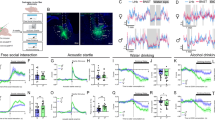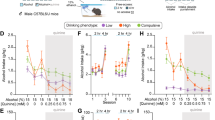Abstract
There are well-established links between impulsivity and alcohol use in humans and animal models; however, whether exaggerated impulsivity is a premorbid risk factor or a consequence of alcohol intake remains unclear. In a first approach, human young (18–25 years) social binge and non-binge drinkers were tested for motor impulsivity and attentional abilities in a human version of the Five-Choice Serial Reaction Time Task (Sx-5CSRTT), modeled on the rodent 5CSRTT. Participants completed four variants of the Sx-5CSRT, in addition to being screened for impulsive traits (BIS-11 questionnaire) and impulsive behavior (by means of the Delay Discounting Questionnaire, Two-Choice Impulsivity Paradigm (TCIP), Stop Signal Reaction Time, and Time Estimation Task). Using a second approach, we compared one of these impulsivity measures, 5CSRTT performance, in two inbred strains of mice known to differ in alcohol intake. Compared with non-bingers (NBD; n=22), binge drinkers (BD, n=22) showed robust impairments in attention and premature responding when evaluated under increased attentional load, in addition to presenting deficits in decision making using the TCIP. The best predictors for high binge drinking score were premature responding in the Sx-5CSRTT, trait impulsivity in the BIS-11, and decision making in the TCIP. Alcohol-naïve C57BL/6J (B6) mice (alcohol preferring) were more impulsive in the 5CSRTT than DBA2/J (D2) mice (alcohol averse); the degree of impulsivity correlated with subsequent alcohol consumption. Homologous measures in animal and human studies indicate increased premature responding in young social BD and in the ethanol-preferring B6 strain of mice.
Similar content being viewed by others
Log in or create a free account to read this content
Gain free access to this article, as well as selected content from this journal and more on nature.com
or
References
Aichert DS, Wostmann NM, Costa A, Macare C, Wenig JR, Moller HJ et al (2012). Associations between trait impulsivity and prepotent response inhibition. J Clin Exp Neuropsychol 34: 1016–1032.
Belknap JK, Crabbe JC, Young ER (1993). Voluntary consumption of ethanol in 15 inbred mouse strains. Psychopharmacology (Berl) 112: 503–510.
Bell RL, Franklin KM, Hauser SR, Engleman EA (2013). Next stop dependence. Binge drinking on the road to alcoholism: preclinical findings on its neurobiology from rat animal models. Binge Eating and Binge Drinking: Psychological, Social and Medical Implications. Nova Science Publishers: New York. pp 1–60.
Crabbe JC, Belknap JK, Buck KJ (1994). Genetic animal models of alcohol and drug abuse. Science 264: 1715–1723.
Dick DM, Smith G, Olausson P, Mitchell SH, Leeman RF, O'Malley SS et al (2010). Understanding the construct of impulsivity and its relationship to alcohol use disorders. Addict Biol 15: 217–226.
Dougherty DM, Mathias CW, Marsh DM, Jagar AA (2005). Laboratory behavioral measures of impulsivity. Behav Res Methods 37: 82–90.
Duka T, Townshend JM, Collier K, Stephens DN (2003). Impairment in cognitive functions after multiple detoxifications in alcoholic inpatients. Alcohol Clin Exp Res 27: 1563–1572.
Evenden JL (1999). Varieties of impulsivity. Psychopharmacology (Berl) 146: 348–361.
Fernie G, Cole JC, Goudie AJ, Field M (2010). Risk-taking but not response inhibition or delay discounting predict alcohol consumption in social drinkers. Drug Alcohol Depend 112: 54–61.
Healey C, Rahman A, Faizal M, Kinderman P (2014). Underage drinking in the UK: changing trends, impact and interventions. A rapid evidence synthesis. Int J Drug Policy 25: 124–132.
Helms CM, Reeves JM, Mitchell SH (2006). Impact of strain and D-amphetamine on impulsivity (delay discounting) in inbred mice. Psychopharmacology (Berl) 188: 144–151.
Hogarth L, Dickinson A, Janowski M, Nikitina A, Duka T (2008). The role of attentional bias in mediating human drug-seeking behaviour. Psychopharmacology (Berl) 201: 29–41.
Logan GD (1994). On the ability to inhibit thought and action: a users' guide to the stop signal paradigm. Inhibitory Processes in Attention, Memory, and Language In: Dagenbach D, Carr T H (eds) Academic pp 189–239.
Loos M, Staal J, Schoffelmeer AN, Smit AB, Spijker S, Pattij T et al (2010). Inhibitory control and response latency differences between C57BL/6J and DBA/2J mice in a Go/No-Go and 5-choice serial reaction time task and strain-specific responsivity to amphetamine. Behav Brain Res 214: 216–224.
MacKillop J, Mattson RE, Anderson Mackillop EJ, Castelda BA, Donovick PJ (2007). Multidimensional assessment of impulsivity in undergraduate hazardous drinkers and controls. J Stud Alcohol Drugs 68: 785–788.
Mehrabian A, Russell JA (1978). A questionnaire measure of habitual alcohol use. Psychol Rep 43 (3 Pt 1): 803–806.
Melges FT, Fougerousse CE Jr (1966). Time sense, emotions, and acute mental illness. J Psychiatr Res 4: 127–139.
Nelson HE, O'Connell A (1978). Dementia: the estimation of premorbid intelligence levels using the New Adult Reading Test. Cortex 14: 234–244.
Patel S, Stolerman IP, Asherson P, Sluyter F (2006). Attentional performance of C57BL/6 and DBA/2 mice in the 5-choice serial reaction time task. Behav Brain Res 170: 197–203.
Patton JH, Stanford MS, Barratt ES (1995). Factor structure of the Barratt Impulsiveness Scale. J Clin Psychol 51: 768–774.
Pena-Oliver Y, Buchman VL, Dalley JW, Robbins TW, Schumann G, Ripley TL et al (2012). Deletion of alpha-synuclein decreases impulsivity in mice. Genes Brain Behav 11: 137–146.
Petry NM (2001). Delay discounting of money and alcohol in actively using alcoholics, currently abstinent alcoholics, and controls. Psychopharmacology (Berl) 154: 243–250.
Petry NM, Kirby KN, Kranzler HR (2002). Effects of gender and family history of alcohol dependence on a behavioral task of impulsivity in healthy subjects. J Stud Alcohol 63: 83–90.
Robbins TW (2002). The 5-choice serial reaction time task: behavioural pharmacology and functional neurochemistry. Psychopharmacology (Berl) 163: 362–380.
Sanchez-Roige S, Pena-Oliver Y, Stephens DN (2012). Measuring impulsivity in mice: the five-choice serial reaction time task. Psychopharmacology (Berl) 219: 253–270.
Saunders JB, Aasland OG, Babor TF, de la Fuente JR, Grant M (1993). Development of the Alcohol Use Disorders Identification Test (AUDIT): WHO Collaborative Project on Early Detection of Persons with Harmful Alcohol Consumption–II. Addiction 88: 791–804.
Scaife JC, Duka T (2009). Behavioural measures of frontal lobe function in a population of young social drinkers with binge drinking pattern. Pharmacol Biochem Behav 93: 354–362.
Stephens DN, Duka T (2008). Review. Cognitive and emotional consequences of binge drinking: role of amygdala and prefrontal cortex. Philos Trans R Soc Lond B Biol Sci 363: 3169–3179.
Townshend JM, Duka T (2002). Patterns of alcohol drinking in a population of young social drinkers: a comparison of questionnaire and diary measures. Alcohol Alcohol 37: 187–192.
Townshend JM, Duka T (2005). Binge drinking, cognitive performance and mood in a population of young social drinkers. Alcohol Clin Exp Res 29: 317–325.
Vonmoos M, Hulka LM, Preller KH, Jenni D, Schulz C, Baumgartner MR et al (2013). Differences in self-reported and behavioral measures of impulsivity in recreational and dependent cocaine users. Drug Alcohol Depend 133: 61–70.
Voon V, Irvine MA, Derbyshire K, Worbe Y, Lange I, Abbott S et al (2014). Measuring ‘waiting’ impulsivity in substance addictions and binge eating disorder in a novel analogue of rodent serial reaction time task. Biol Psychiatry 75: 148–155.
Walker SE, Pena-Oliver Y, Stephens DN (2011). Learning not to be impulsive: disruption by experience of alcohol withdrawal. Psychopharmacology (Berl) 217: 433–442.
Worbe Y, Irvine M, Lange I, Kundu P, Howell NA, Harrison NA et al (2013). Neuronal correlates of risk-seeking attitudes to anticipated losses in binge drinkers. Biol Psychiatryhttp://dx.doi.org/10.1016/j.biopsych.2013.11.028.
Worbe Y, Savulich G, Voon V, Fernandez-Egea E, Robbins TW (2014). Serotonin depletion induces 'waiting impulsivity' on the human four-choice serial reaction time task: cross-species translational significance. Neuropsychopharmacology 39: 1519–1526.
Acknowledgements
We thank Dr Kyriaki Nikolaou and Ms Sasha Ellis-Pridgeon for help in performing the human experiments.
Author information
Authors and Affiliations
Corresponding author
Additional information
Supplementary Information accompanies the paper on the Neuropsychopharmacology website
Supplementary information
Rights and permissions
About this article
Cite this article
Sanchez-Roige, S., Baro, V., Trick, L. et al. Exaggerated Waiting Impulsivity Associated with Human Binge Drinking, and High Alcohol Consumption in Mice. Neuropsychopharmacol 39, 2919–2927 (2014). https://doi.org/10.1038/npp.2014.151
Received:
Revised:
Accepted:
Published:
Issue date:
DOI: https://doi.org/10.1038/npp.2014.151
This article is cited by
-
Effects of quinpirole in the ventral tegmental area on impulsive behaviour during performance on the five-choice serial reaction time task
Experimental Brain Research (2023)
-
Effects of early life stress and adolescent ethanol exposure on adult cognitive performance in the 5-choice serial reaction time task in Wistar male rats
Psychopharmacology (2017)
-
Theory of Visual Attention (TVA) applied to mice in the 5-choice serial reaction time task
Psychopharmacology (2017)
-
Binge Drinking: Current Diagnostic and Therapeutic Issues
CNS Drugs (2017)
-
Individual differences in voluntary alcohol intake in rats: relationship with impulsivity, decision making and Pavlovian conditioned approach
Psychopharmacology (2017)



